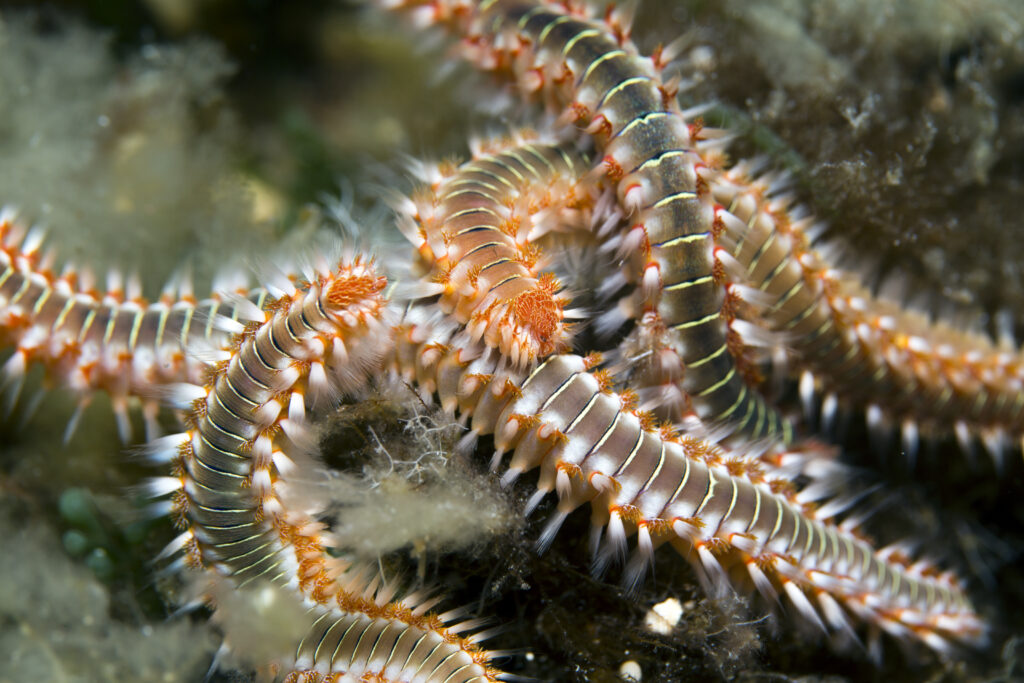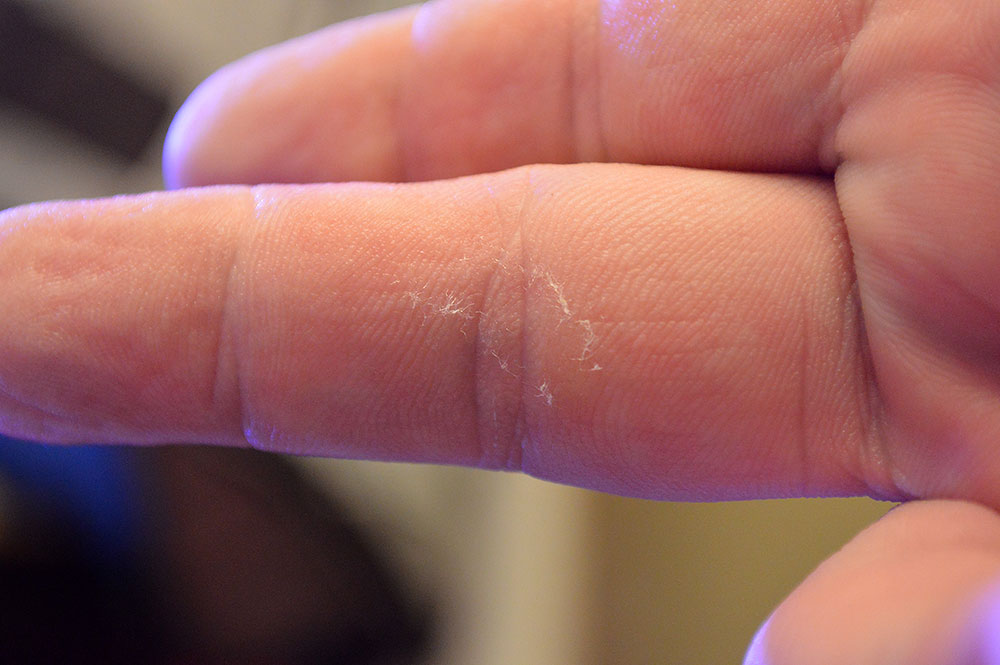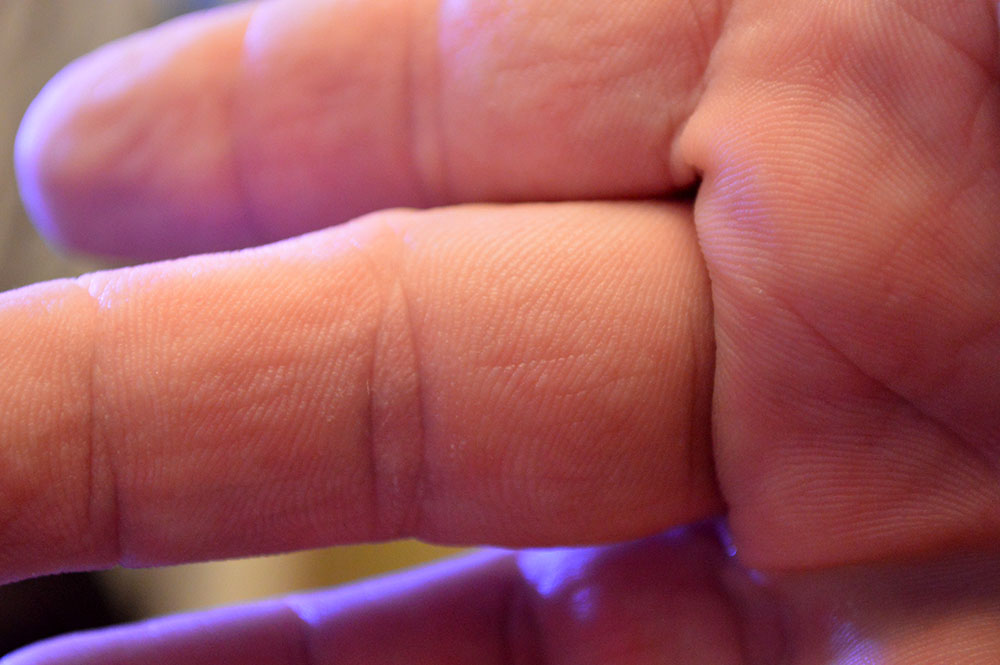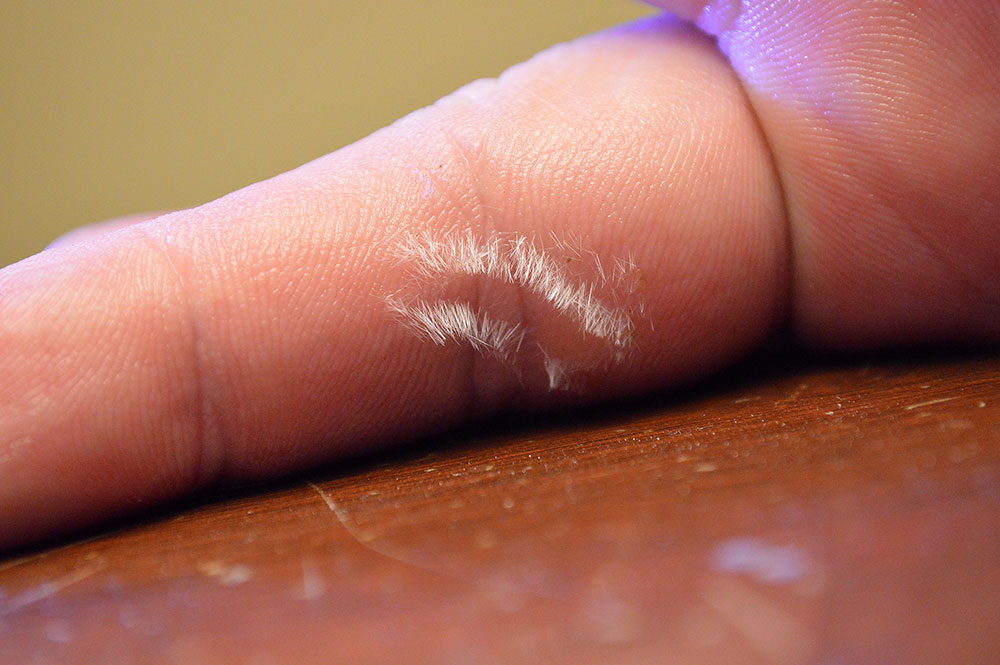
While aquarists have somewhat rethought their relationship with bristleworms as scavengers vs. pests, they still remain one of the tank inhabitants that won’t think twice about inflicting pain upon you. Image by Silke Baron | CC – BY – 2.0
I was rummaging through old photography recently and came across something I had documented, but never shared. During the teardown of a reef tank, I inadvertently nailed myself with a bristleworm…and not a little one. This wasn’t the coral-eating “Fire Worm,” but simply a large representative of the more benign scavengers that tend to populate most reef tanks.
Still, this little patch of dozens (hundreds?) of tiny spines in my skin was irritating. Having been stung more than once, I can say that even the small ones elicit a painful response. While I can’t really say they also “itch” in the classic sense, they certainly generate a response that makes you want to scratch, well after the spines are dealt with. While I’ve never experienced them, swelling, inflammation, numbness, and rashes have been reported following bristleworm stings. Before I go further, it bears reminding that for some people, a bristleworm sting can be a serious problem requiring medication attention. Pay attention to your symptoms; WebMD suggests that any bristleworm sting is probably worthy of a call to the doctor.
The actual sting is caused by the tiny bristles, called chaetae, becoming embedded in your skin. Chaetae are the hollow, calcareous spines that line the body of the bristleworm. In my quick reading-up, it’s really unclear as to whether all species of bristleworms have venom associated with their spines, or only certain species. If the venom varies or is absent in some species, this could explain the wide range of differing reactions people report. [UPDATE – See Ron Shimek’s investigation on whether bristleworms, and specifically fireworms, are venomous or not!]
The sting of a bristleworm is something none of us want to deal with, but it is one of the hazards of the reef aquarium hobby, and hobbyists should probably be aware of the first aid options. I was rather surprised, however, to see that apparently this is a common enough problem that even WebMD has a section covering the treatment of bristleworm stings. On the short list of treatments and remedies:
- Remove the spines, either with tweezers, using various forms of tape (including Duck Tape or even lint rollers) to adhere to the spines and pull them out, or dissolve the bristles with household vinegar.
- Apply hydrocortisone ointment to relieve burning and inflamation
- Use over-the-counter painkillers, such as acetaminophen or ibuprofen, to relieve pain.
(for full first aid instructions, and more detailed info, visit WebMD).
So when I got stung, I took one look at this and said, “Tweezers are going to be a waste of time,” and the application of something like tape seems like it would have been more irritating. I opted to go the vinegar route. After several minutes, this is what the spines looked like:

After several minutes of soaking in ordinary household white vinegar, the bristleworm spines, aka chaetae, are partially dissolved.
It was somewhat boring just sitting looking at the tank, my finger soaking in a cup full of vinegar while the acetic acid ate away at the chaetae. This certainly wasn’t the quickest solution. Did it work? Take a look at the next image:

Finally, after a total soak of probably 15 minutes or more, the offending spines are gone. The irritation is reduced, but still persists for a little while.
After the soak, I had no further need for topical antihistamines or pain killers. I hope your reactions to a bristleworm sting are as mild as mine were. Next time, wear gloves; that’s an easy way to prevent this sort of thing from happening again!
Have you been stung by bristleworms? What did you do, and what worked best to alleviate your discomfort? Tell us in the comments below!






Thank you very much for sharing. It is not often I run into large bristle worms, but it has happened with new accounts and it is not pleasant!
Ouch, moved around some rocks last night – oh geez, my one finger hurts like anything! Looking for some vinegar now! Thanks!
I bought a second hand tank fully stocked I helped take living rock out the tank and at my end put it back in my hand was stinging I just thought I cut it and the salt water was stinging it later I rubbed my eye and the pain was so bad I went to a&e they sent me strict over to bristol eye hospital they put drops in my eye the next day I went back as it was getting worse at this point my hand had 5 stings on it and then I realised I rubbed my eye and one of the bristle worm hairs had entered my eye I was kept in for five days drops every hour day and night I went home and continue to do drops every 2 hours day and night they sent me to London for a eye scan and they could see the hair then I went back and done a wash out of the chambers in my eye that was a week ago but still far from right just hoping time will heal
Will Apple cider vinegar work for any bristles that may be left in my skin??
Allie, I think it would work the same; it’s the acidity of the vinegar dissolving the bristles, so the type of vinegar likely wouldn’t matter.
OMG!!! YOU SAVED ME!! I have been going insane trying to figure out what stung my finger after moving some rocks around. One of my reef friends mentioned bristles but I couldn’t see anything. I decided to just put it in vinegar and as soon as I put my finger in the bristles glowed! I watched them bubble up and after about 15 minutes were gone. I would post pics but the comments dont allow an option. Thank you so much for posting, hopefully I will be back!
I was stung on my finger. I was sure I got all the bristles out… however 1 week later my finger is hard where the sting was and several under the skin bubble like dots have appeared under my skin? The dots look reddish purple..its not crazy painful, but it is very uncomfortable… any one run into this before? Will a vinager soak help even though the skin appears closed from the stings? Is it possible there still inside my skin?
Hi
I was stung on my foot in Bali at sunset in a rock pool. Had no idea what it was at the time but scraped the bristles out and ran isopropyl alcohol and detol over it for a couple of days. Fast forward 7 months and it’s still intermittently aches exactly where bristles were. Any suggestions?! Any one else found the same?
Yes, I had bristleworms in my aquarium and I would try to rearrange the rock and have been stung many times when they were hiding under the rock. I would use white vinegar and it would quickly dissolve the bristles that were stuck in my hand. Usually it was on my finger so I would just dip my finger into a small cup filled with vinegar for about 30 seconds.